Physical Address
304 North Cardinal St.
Dorchester Center, MA 02124
The growth of the eye from infancy to adulthood is a complex, sequential process with the anterior portion of the eye developing earlier than the posterior portion. The newborn infant eyeball measures 16.5 mm in axial length, and is 70% of the adult size. The anterior chamber between the cornea and the iris grows rapidly in the first 2 years, followed by the slower, gradual posterior segment development into the teenage years. Vision development begins in utero, with a steep increase over the first months of life.
Vision development in neonates depends on the development of visual pathways and their expected interactions. These pathways include the occipital lobe visual cortex, the lateral geniculate nucleus (LGN) in the thalamus, and the synaptic transmission of neurons between the eye, LGN, and visual cortex.
A neonate has only one-third the adult number of cones, causing blurred central vision. Foveal cone density increases from 18 cones/100 μm at 1 week of age to 42 cones/100 μm by 18 years. Migration of retinal cones from the periphery to the fovea occurs during this time. Maturation of the fovea and differentiation of the macular retinal layers responsible for sharp acuity, color vision, and contrast sensitivity occur between 6 weeks and 8 months of age. Color vision is present in infants as young as 2 months.
Response to bright light occurs as early as 25 weeks gestational age. Forced preferential looking tests establish visual discrimination in infants by 31–32 weeks of gestation, with premature infants achieving vision comparable to full term acuity by 37 weeks. Vision in a neonate is limited to 8–12 inches, and approximates 20/400. Vision improves significantly over the following 8 weeks, reaching the 20/200 level with initiation of eye contact. By 6 months, infants can see in the 20/100–20/150 range, reaching 20/20 by 2 years of age ( Table 4.1 ). Various electrophysiology tests of infant vision development have been published. Data from sweep visual evoked potential testing, which measures cortical visual responses to a grating fixation target, suggest that infants have 20/130 vision by 1 month of age and achieve 20/30 vision by age 13 months ( Fig. 4.1 ).
| Technique | Newborn | 2 months | 4 months | 6 months | 1 year |
|---|---|---|---|---|---|
| Optokinetic nystagmus | 20/400 | 20/400 | 20/200 | 20/60 | |
| Preferential looking (one study) | 20/400 | 20/200 | 20/200 | 20/150 | 20/50 |
| Preferential looking (other study) | 20/800 to 20/1600 | 20/1200 | 20/400 | 20/300 | 20/100 |
| Visual evoked potential | 20/100 to 20/200 | 20/80 | 20/80 | 20/20 to 20/40 | 20/40 |
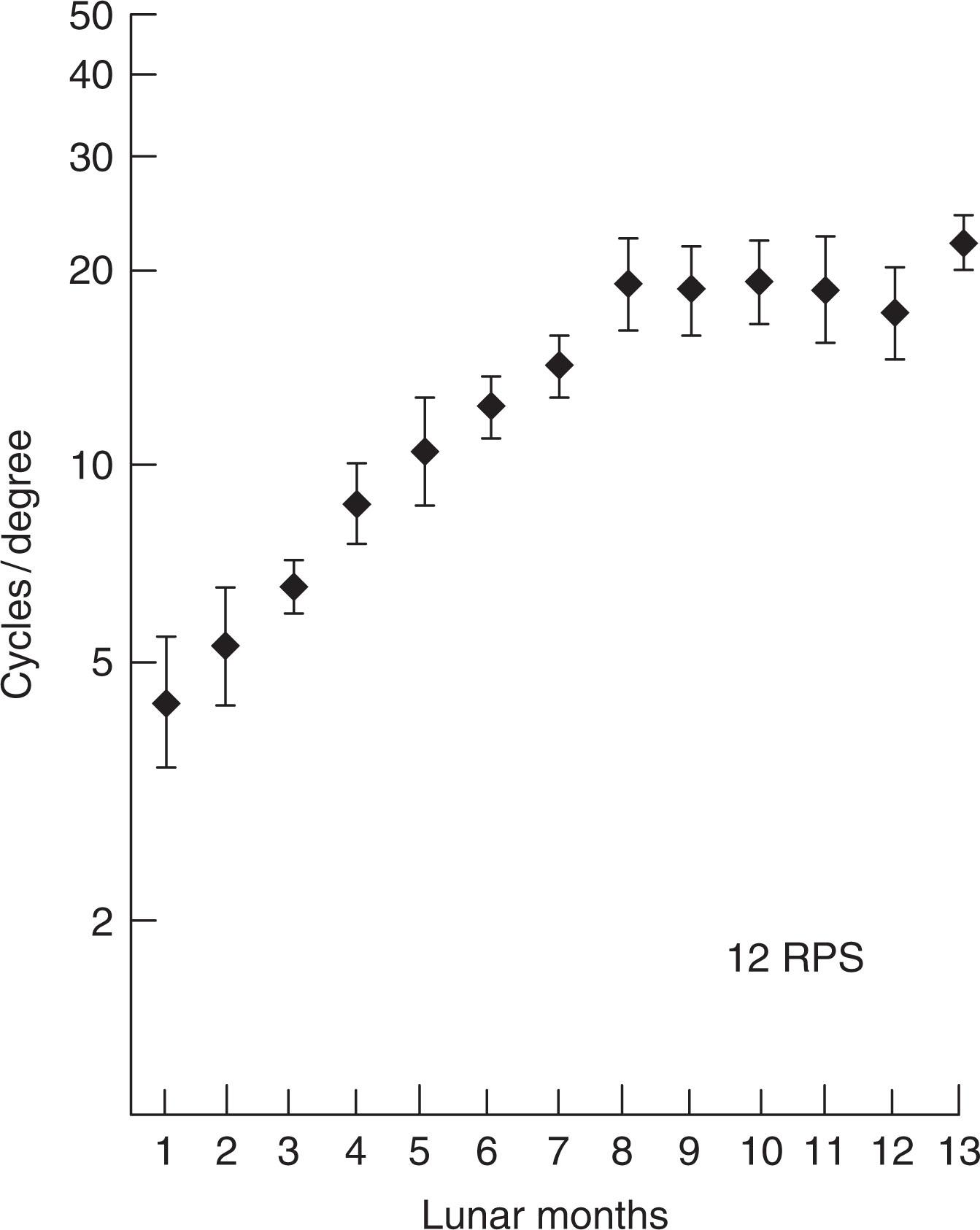
The pupillary light response is present by 25 weeks gestational age, and at 1 month of age, the pupil size is 1–2 mm smaller than adult pupil size. By 2 months of age, infants have similar pupil size to adults at luminances above 7 cd/m but not at lower luminances.
Accommodation occurs by 3 months, and pursuit and saccade movements occur as early as 1 month old. Pursuit movements occur slightly later, at 6–8 weeks. Before then, infants perform micro saccades instead of a smooth pursuit movement to track a moving target.
Binocular interaction and ability to detect stereopsis occurs between 11 and 18 weeks, with rapid improvement once it occurs. Binocular acuity in infants is better than monocular acuity after 6 months of age.
Abnormalities in the distance between the inner and the outer canthi and the size and shape of the palpebral fissure are important features in craniofacial malformations, genetic abnormalities, and fetal alcohol syndrome.
Palpebral fissure changes in early childhood have been studied by analyzing digital imaging : during the first 3 months of life, the upper eyelid is at its lowest position, later rising to its maximum height between 3 and 6 months of age, and then declining until adulthood. The lower eyelid is close to the pupil center at birth, dropping until the age of 18 months when its position stabilizes. A single lower eyelid crease is common at birth, a double crease at the age of 36 months. Figure 4.2 shows the linear relationship between gestational age and orbital margin horizontal (OMH), as well as vertical (OMV) diameters in the unborn child. There is a linear relationship between gestational age and conjunctival fornix horizontal (CFH) and conjunctival fornix vertical (CFV) diameters ( Fig. 4.3 ).
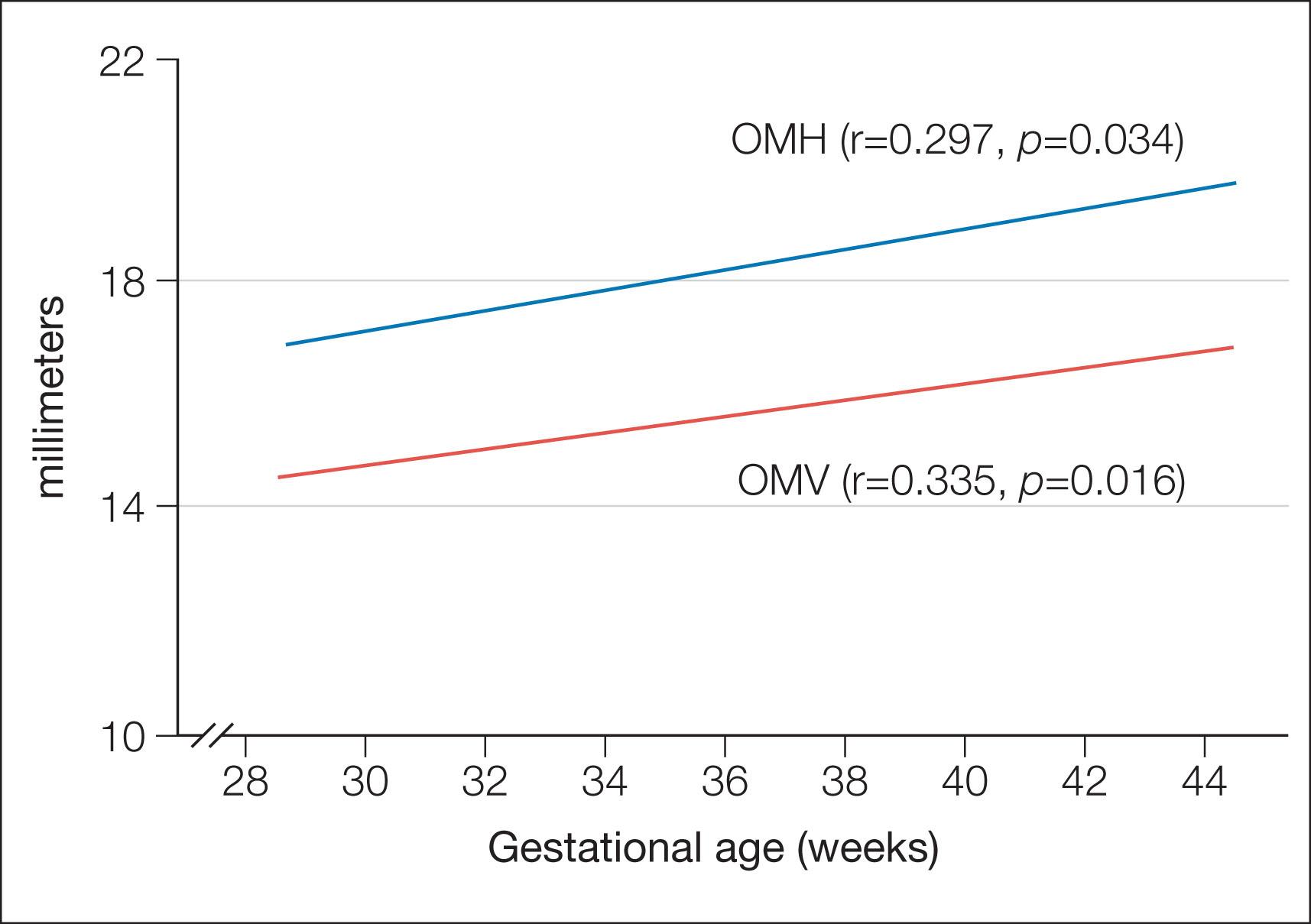
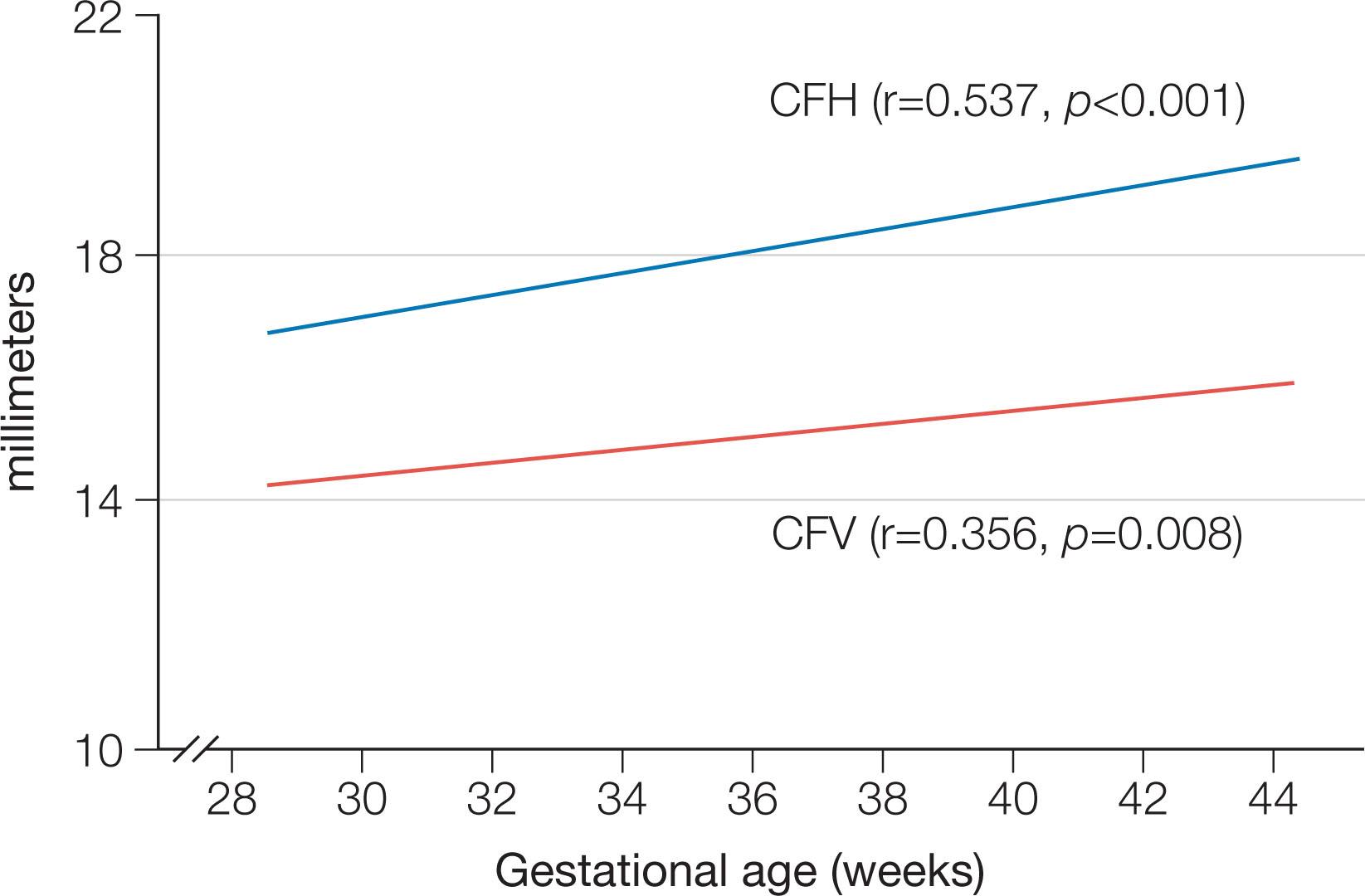
The palpebral fissure's horizontal length is 15 ± 2 mm at 32 weeks of gestation, 17 ± 2 mm at birth, 24 ± 3 mm at 2 years of age, and 27 ± 3 mm at the age of 14 ( Fig. 4.4 ). Inter-racial differences exist: the palpebral fissure is longer in African Americans. Inner canthal distance and outer orbital distance are 16 and 59 mm, respectively, in premature infants; 20 ± 4 and 69 ± 8 mm in newborn babies; 26 ± 6 and 88 ± 10 mm at the age of 3 years; and 31 ± 5 and 111 ± 12 mm at the age of 14 ( Fig. 4.5 ).
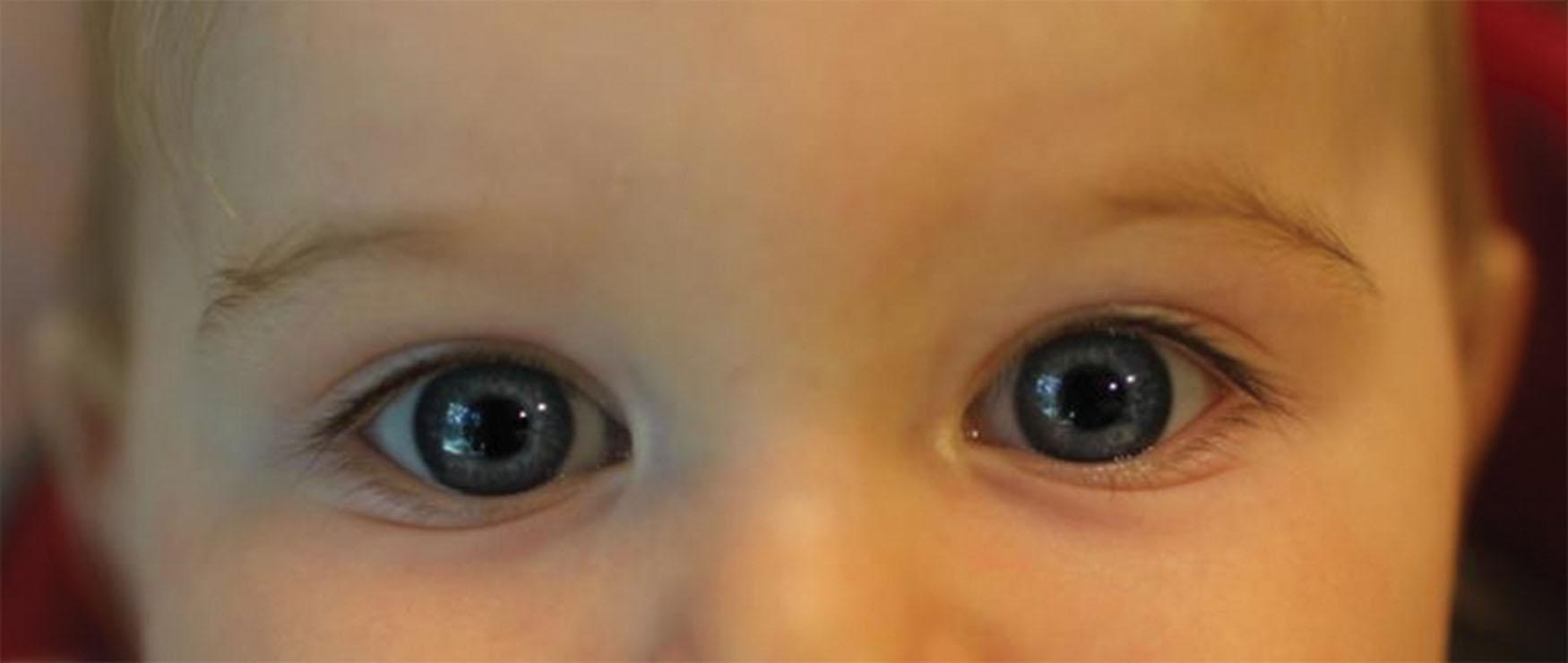
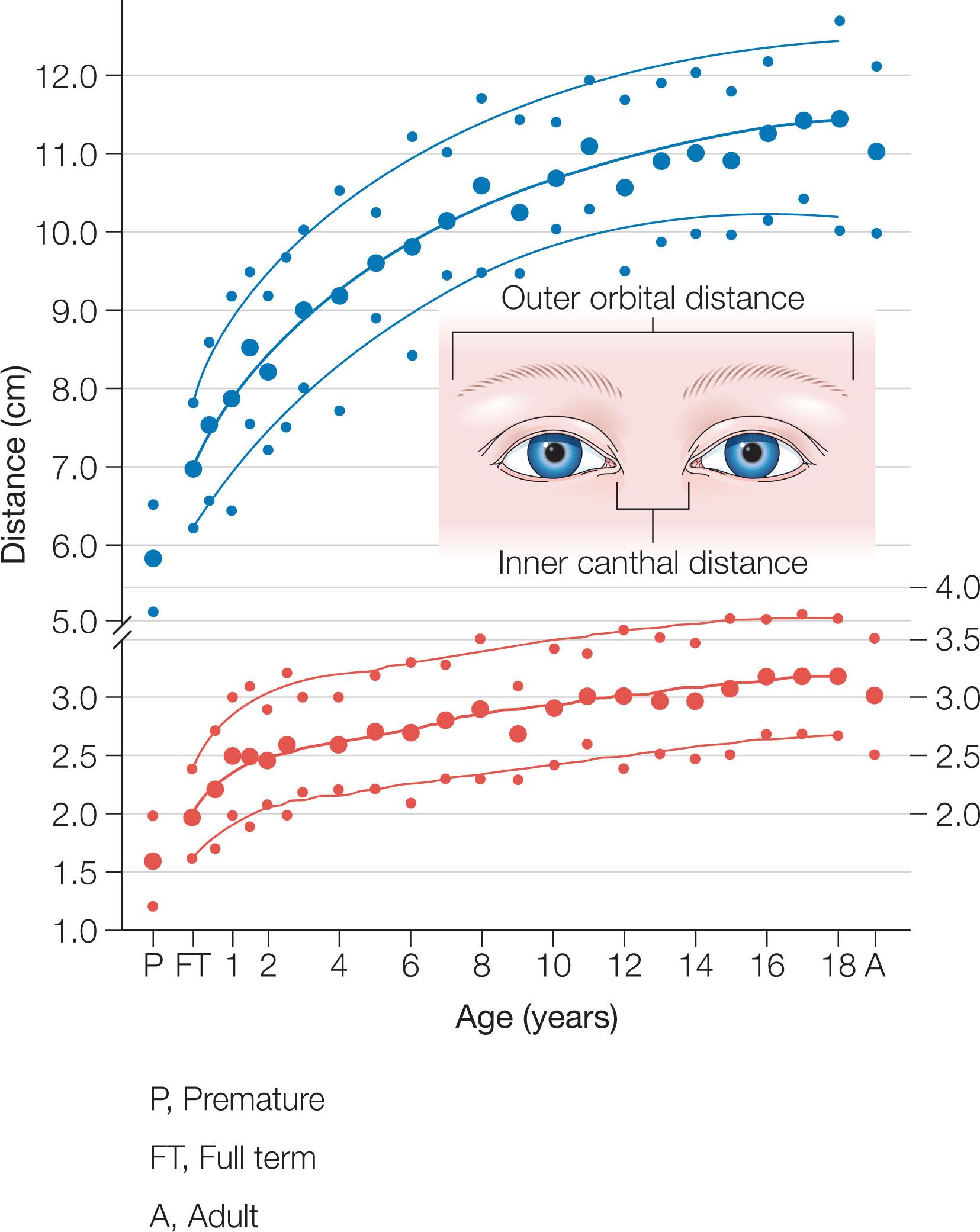
Tearing is not a problem when holding the eyelids of the youngest premature babies open. Later, in preterm babies (30–37 weeks after conception), mean basal tear (with topical anesthesia) secretion is 6.2 (±4.5 SD) mm and at term 9.2 (±4.3) mm tested with a Schirmer tear test strip (5 minutes). Mean reflex tear secretion is 7.4 (±4.8) mm in preterm and 13.2 (±6.5) mm in term infants. Non-invasive tear film break-up time in normal children was recently published to be 21.76 ± 4.06 seconds (range 14.9–30.95 s) in children mean age 7.64 years (range 2.16–15.83 years). This is significantly longer in children than adults and consistent with a lower blink rate of 6 blinks per minute in newborns and 8 blinks per minute for preschool-age children.
Congenital alacrima is rare but has recently been reported in blepharophimosis syndrome with absent lacrimal glands. Tear production is often reduced even if lacrimal glands are identified and anatomically intact, implying abnormal function of the glands.
Tactile corneal reflex develops neurologically over several weeks after birth. The reflex is present in 25% of newborns at 1 week of age, 75% at 6 weeks, and 100% by 12 weeks. Postpartum age of the infant correlates better with the presence of the reflex than gestational age.
The horizontal and vertical corneal diameters at birth are 9.5–10 mm, attaining adult size by 1–3 years of age. The period of most rapid corneal growth is the first 6 months of life. The newborn cornea is also steeper than the adult cornea, and is more curved peripherally than centrally.
Keratocyte density is around 60,000 cells/mm in infancy with a decline of 0.3% per year through life.
Endothelial cell density (ECD) is inversely related to corneal diameter and surface area from birth to age 2 years. After this, ECD decrease is inversely related to age, similar to rates seen in adults. The decrease is a normal part of the corneal maturation process. Endothelial cell counts exceed 10,000 cells/mm at 12 weeks of gestation. Endothelial cell decreases at a faster rate between 1 and 2 years of age than between 2 and 5 years of age (334 vs. 100 cells/mm per year), as shown in Table 4.2 . Mean ECD is 4056 cells/mm at birth, 3782 cells/mm 2 at 2 years, and 3582 cells/mm 2 at 4 years. Mean ECD under 5 years of age is 3746 ± 370 cells/mm 2 . Average endothelial cell count was 3500 cells/mm 2 in the unoperated eyes of a large cohort of 5-year-old children who underwent unilateral cataract surgery. Mean endothelial cell count in older healthy children was 2696 cells/mm 2 in one study. No significant cell count differences were noted between 5 and 20 years of age.
| Age group (years) | Mean age(years ± SD) | Mean ECD (cells/mm 2 ± SD) | Corneal diameter (mm ± SD) |
|---|---|---|---|
| 0–1 | 0.5 ± 0.3 | 4056 ± 451 | 11.5 ± 0.6 (18) |
| 1–2 | 1.6 ± 0.3 | 3722 ± 386 | 12.1 ± 0.3 (22) |
| 2–3 | 2.4 ± 0.3 | 3782 ± 302 | 12.1 ± 0.4 (15) |
| 3–4 | 3.5 ± 0.3 | 3686 ± 313 | 11.9 ± 0.4 (10) |
| 4–5 | 4.5 ± 0.3 | 3582 ± 254 | 12.2 ± 0.2 (5) |
The cornea is thicker in premature infants than full-term newborns. Central corneal thickness (CCT) in premature infants younger than 33 weeks reaches a mean of 0.656 mm (SD ± 0.103 mm) 5 days postnatally, and 0.566 (SD ± 0.064) at the age of 110 days. In full-term neonates, CCT is 0.573 ± 0.052 mm (range 0.450–0.691 mm) with a peripheral corneal thickness of 0.650 ± 0.062 mm (range 0.520–0.830 mm). Another study confirmed the above data and also measured peripheral corneal thickness: superior corneal thickness was 0.696 ± 0.055 mm, inferior was 0.744 ± 0.062 mm, nasal was 0.742 ± 0.058 mm, and temporal was 0.748 ± 0.055 mm. A multicenter study including more than 2000 children found thicker median CCT with increasing age from 1 to 11 years, reaching a plateau after 11 years. African American children were found to have thinner mean CCT by approximately 20 µm between 4 and 17 years of age than White and Hispanic children. This racial difference in CCT has also been noted in adults. Reference percentiles by race and age are included in Tables 4.3A and 4.3B . Intraocular pressure measured 1.5 mmHg higher for every 100 µm thicker CCT, and only up to 2 mmHg could be attributed to variation in CCT ( Fig. 4.6 ).
| Age (yr) | 5th | 10th | 25th | 50th | 75th | 90th | 95th |
|---|---|---|---|---|---|---|---|
| 1 | 493 | 506 | 528 | 553 | 578 | 600 | 614 |
| 2 | 495 | 509 | 531 | 556 | 581 | 603 | 617 |
| 3 | 498 | 511 | 534 | 559 | 583 | 606 | 619 |
| 4 | 500 | 514 | 536 | 561 | 586 | 608 | 622 |
| 5 | 503 | 516 | 538 | 563 | 588 | 610 | 624 |
| 7 | 506 | 520 | 542 | 567 | 592 | 614 | 627 |
| 9 | 509 | 523 | 545 | 570 | 595 | 617 | 630 |
| 12 | 512 | 525 | 548 | 573 | 597 | 620 | 633 |
| 15 | 513 | 526 | 549 | 574 | 598 | 621 | 634 |
| 17 | 513 | 526 | 548 | 573 | 598 | 620 | 634 |
| Age (yr) | 5th | 10th | 25th | 50th | 75th | 90th | 95th |
|---|---|---|---|---|---|---|---|
| 4 | 483 | 496 | 517 | 541 | 565 | 587 | 600 |
| 5 | 484 | 497 | 519 | 543 | 567 | 589 | 602 |
| 7 | 487 | 500 | 521 | 545 | 569 | 591 | 604 |
| 9 | 489 | 502 | 523 | 547 | 572 | 593 | 606 |
| 12 | 491 | 504 | 525 | 550 | 574 | 595 | 608 |
| 15 | 492 | 505 | 526 | 551 | 575 | 596 | 609 |
| 17 | 492 | 505 | 527 | 551 | 575 | 596 | 609 |
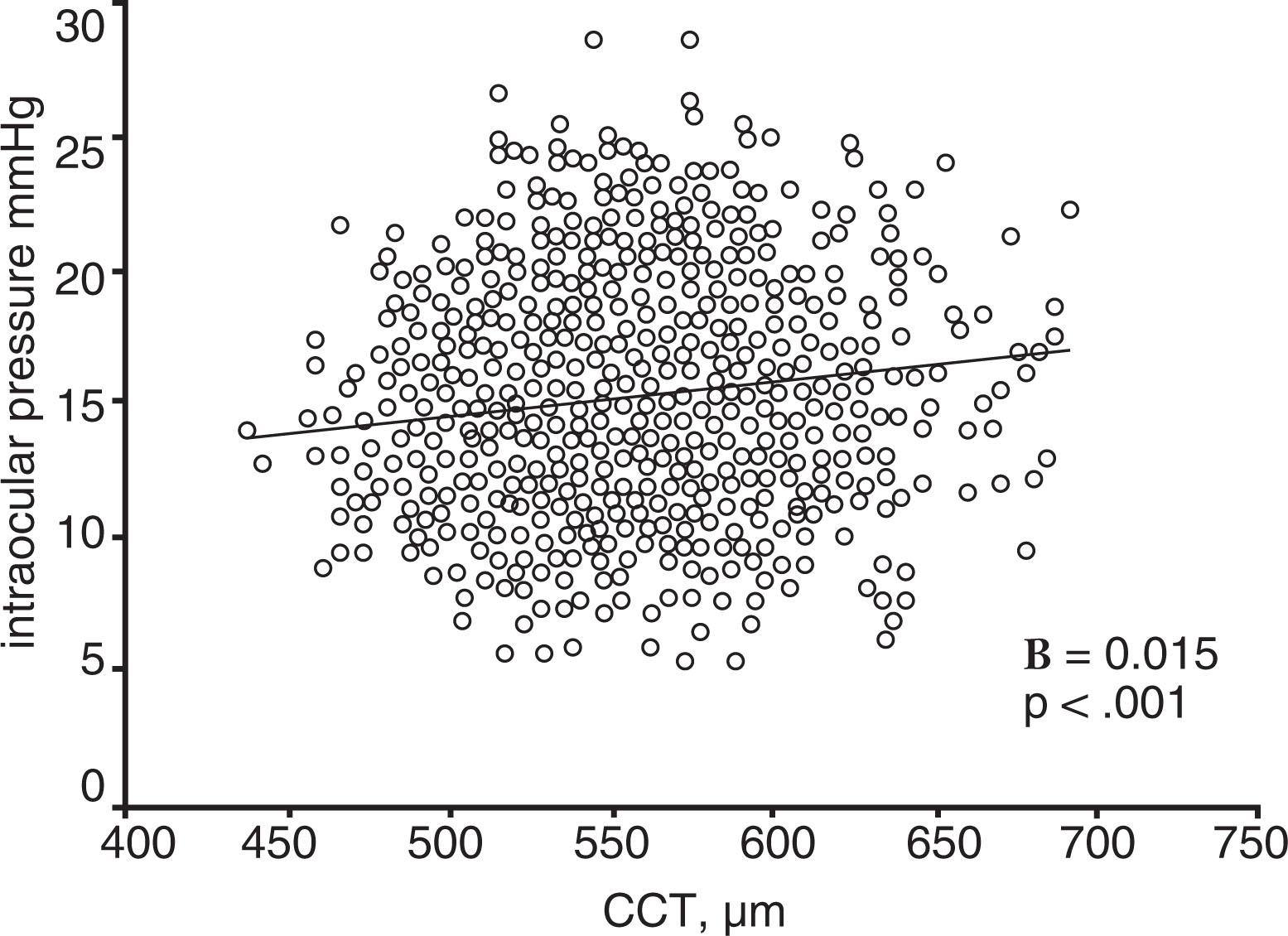
Most of the enlargement of the eye is in the first 6 months of extrauterine life. All diameters increase. The cornea and the iris reach about 80% of their adult dimensions at birth. The posterior segment grows more postnatally, as can be seen in Tables 4.4A to 4.4C . The thickness of the sclera in 6-, 9-, and 20-month specimens is 0.45 mm, similar to that of adult eyes.
| Age | No. of specimens | Superior | Medial | Inferior | Lateral |
|---|---|---|---|---|---|
| Neonatal | 10 | 7.5 | 7.6 | 6.8 | 6.9 |
| 2−3 months | 4 | 7.3 | 6.8 | 6.7 | 7.0 |
| 6 months | 4 | 8.9 | 9.0 | 8.3 | 8.4 |
| 9 months | 4 | 8.8 | 8.7 | 8.3 | 8.2 |
| 20 months | 2 | 10.2 | 8.9 | 9.3 | 7.8 |
| Adult | 5 | 10.8 | 10.5 | 9.8 | 9.2 |
| Age | No. of specimens | Superior | Medial | Inferior | Lateral | ||||
|---|---|---|---|---|---|---|---|---|---|
| Nasal end | Temporal end | Sup. end | Inf. end | Nasal end | Temporal end | Sup. end | Inf. end | ||
| Neonatal | 10 | 6.1 | 7.6 | 4.7 | 5.3 | 6.0 | 6.6 | 6.4 | 5.8 |
| 2 months | 3 | 5.5 | 5.8 | 5.2 | 6.0 | 5.2 | 6.2 | 7.8 | 5.8 |
| 3 months | 3 | 6.9 | 7.5 | 5.1 | 5.8 | 6.6 | 7.5 | 7.5 | 7.0 |
| 6 months | 4 | 7.4 | 8.3 | 5.8 | 6.6 | 7.2 | 9.0 | 7.2 | 7.1 |
| 9 months | 4 | 7.2 | 9.3 | 6.2 | 6.9 | 7.7 | 8.8 | 7.5 | 7.1 |
| 20 months | 2 | 7.1 | 8.7 | 7.3 | 7.6 | 8.5 | 9.3 | 8.5 | 8.5 |
| Adult | 5 | 7.4 | 10.0 | 7.8 | 7.7 | 8.0 | 9.2 | 8.4 | 8.5 |
| Age | No. of specimens | Superior oblique | Inferior oblique | ||||||
|---|---|---|---|---|---|---|---|---|---|
| To cornea | To optic nerve | To cornea | To optic nerve | ||||||
| Ant. edge | Post. edge | Ant. edge | Post. edge | Ant. edge | Post. edge | Ant. edge | Post. edge | ||
| Neonatal | 8 | 9.0 | 11.6 | 10.6 | 5.6 | 10.2 | 14.8 | 8.6 | 2.2 |
| 2–3 months | 4 | 10.3 | 12.8 | 10.3 | 5.6 | 12.1 | 16.2 | 8.2 | 2.3 |
| 6–9 months | 8 | 12.3 | 14.2 | 12.0 | 6.4 | 13.9 | 18.0 | 10.8 | 3.2 |
| 20 months | 2 | 14.2 | 15.3 | 12.2 | 7.8 | 15.5 | 19.3 | 11.7 | 4.6 |
| Adult | 3 | 14.7 | 17.7 | 14.6 | 8.3 | 16.2 | 20.5 | 14.2 | 6.6 |
Recent studies imaging extraocular muscle insertions using anterior segment optical coherence tomography (AS OCT) show high reproducibility in locating horizontal rectus muscles in unoperated eyes. Almost 90% of imaged extraocular muscle insertions were within 1 mm of the insertion site found intraoperatively, including vertical rectus muscles, with 77% accuracy noted in reoperated muscles. Successful imaging was performed in children as young as 4 years of age ( Fig. 4.7 ). Using a combined color modality to enhance standard AS OCT, the accuracy of locating muscle insertions was 94% in primary surgery and 60% in reoperations.

Become a Clinical Tree membership for Full access and enjoy Unlimited articles
If you are a member. Log in here